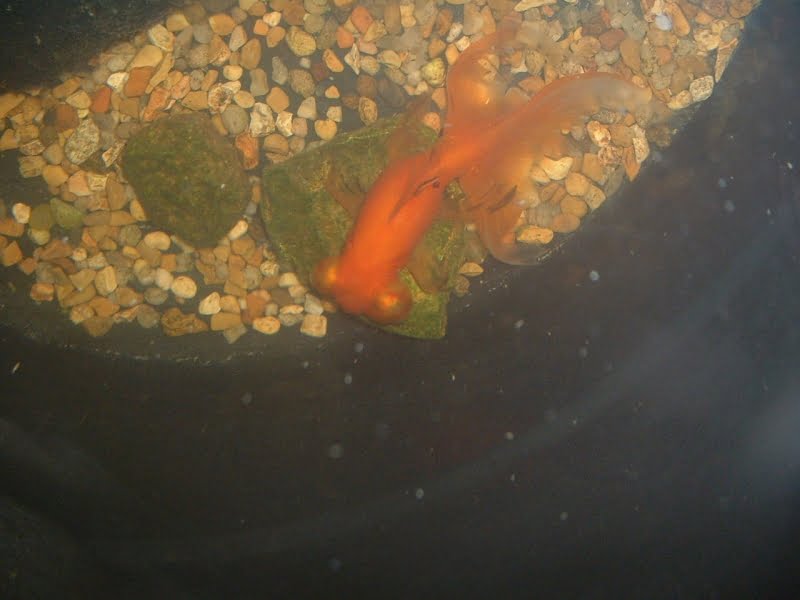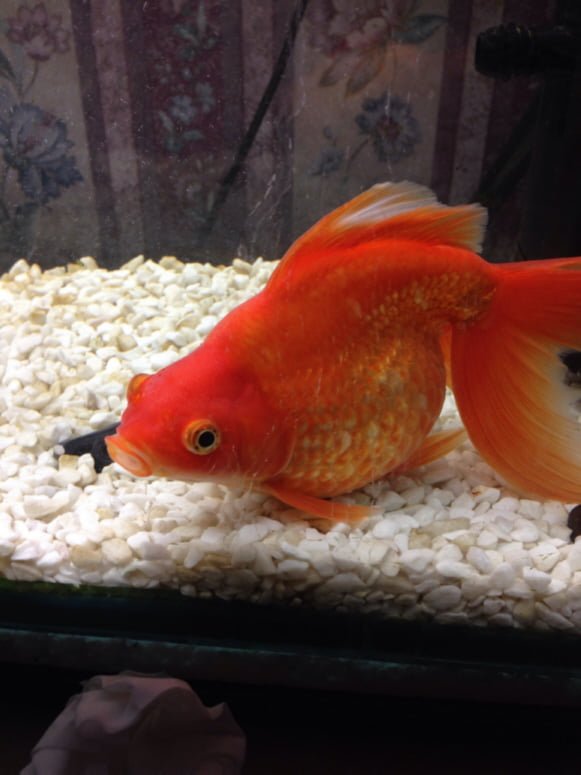Bottom sitting may not be related to nitrate issues
Bottom sitting has a wide range of definitions when it comes to fish. The first thing that comes to mind when a fish is bottom sitting is the nitrate levels are too high, but this isn’t always the case. Goldfish or Koi affected by nitrates do lay on the bottom. The increased weight or pressure of the water relieves the pressure caused by nitrates. You may even see them wedged in the gravel to get even lower, but some fish may be in distress over ammonia or nitrite levels or may have a simple sinking issue caused from lack of food
Fish laying on their side may be unconscious or even dying
Goldfish laying on side
Some fish are purposefully fed less to keep the aquarium or pond cleaner. Some fish are fed less to avoid or cure constipation. Some are even fasted. Never, for any reason withhold food, no matter what you’ve read. Constipation isn’t cured by fasting, but results in more serious conditions
A cleaner fish house is achieved by following the 10 steps to goldfish and koi keeping
Symptoms: fish is laying on bottom; fish is bottom sitting; fish can’t get off the bottom; fish is pressed to bottom; fish is laying on side and on the bottom; fish cannot lift
Goldfish can’t swim

Perched on a clam shell, the fish in the photo above is not bottom sitting due to high nitrates. After several days of not eating,or perhaps not being fed, the absence of Co2 levels in the intestinal tract caused the swim bladder to loose the ability to function
Bottom sitting
Within a few days time of going without food, the fish’s swim bladder collapsed. The fix is a long one. It will take several weeks if not a few months of daily hand feedings to get the bladder functioning again. If the condition is left for too long, the bladder fuses together; the fish will spend it’s life laying on the floor helplessly, but luckily, after six long weeks this fish made a recovery; determined to swim again
Feeding fish with a sinking disorder requires a lot of patience. At first, the fish may be afraid of the fingers that make the offering, however, if the fish isn’t sick, it will have an appetite, and in a short time will respond, taking the bait. These fish should be fed several small meals daily, that stretch from early morning until late night. Encourage the fish to move around. Keep the fish in shallow water. Deep water will discourage the swim bladder organ from filling
Fish with no appetite may be suffering from nitrate poisoning. Placing it in shallow water could injure it further
The fish in the photo below is in water with nitrates reading of 60 ppm. It was okay, until it’s owner performed a large water change. The sudden change in water depth increased the pressure of the nitrates, and now the fish is bottom sitting. He’ll pass on supper tonight. Nitrates take a large toll on fish. Their owners unaware. Goldfish affected by nitrates typically have little to no appetite, and if the condition worsens, due to continuously rising nitrates, the fish begins to curl until it dies an agonizing death

As a fish rises, its swim bladder organ fills with carbon dioxide, which enables the fish the action. The higher the fish in the water, the more expanded the tract. When the fish is at the halfway mark, the bladder will be half filled
It’s catch 22 for some of these fish. A fish that has a collapsed bladder is trapped on the bottom. If the water is deep, the bladder will not fill even if the fish begins eating again. The greater the water depth, the less air in the bladder. In these cases shallow water is recommended, but first, make certain the fish has no nitrate issues. If a fish’s sinking issues was originally caused by nitrates, best to wait until it’s fully recovered before attempting to lower the water table
Deep water discourages bladder function whether it’s a floating issue or a sinking issue. Goldfish with floating issues may be suffering from an impacted tract, better known as constipation. These fish have Co2 trapped in the bladder, and cannot sink at will, although being in shallow water helps to relieve the pressure, giving them a little more control of swimming. Never force a fish suffering from a floating issue to the bottom. It’s bladder could burst
Instead of learning to live with floating issues or sinking issues, learn how to resolve them. In most every case, the condition can be reversed
There are cases where the fish’s bladder is permanently damaged, and may not respond to treatment. A fish with a floating issue forced to the bottom (for its own good) may end up with a ruptured bladder. A loud clap of thunder or an explosion in close proximity could also rupture the bladder if filled to it’s limit at the time
If your fish has no appetite, for whatever reason, it’s at risk of developing a sinking issue. Continue tempting it with tasty morsels, but if a few days go past, and the fish still isn’t eating, it may be necessary to force feed
If your fish is stuck on the bottom, and you’re certain nitrates aren’t an issue, lower the water table or set the fish up in a tub for a few days. Read
To increase Co2 levels in the tract, feed nothing but Lima (soft beans free of additives) beans; rich in nutrients or peas. Most fish love them. Remove the skins before serving
Author: Brenda Rand